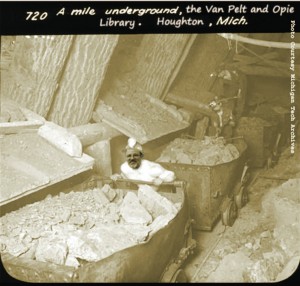It’s been a busy fall semester for the Archives. Nine individual classes have incorporated archival sources into their coursework this semester, which means at least 200 students were regulars in the reading room over the past 15 weeks, studying different aspects of the University’s history, such as broomball, the Pep Band, and the Ford Forestry Center, as well as poring through civic and mining company records in search of documentation on the Quincy Smelter, the lives of copper miners, the history of the St. Mary’s Falls Ship Canal Company.
Although the semester is winding down, we’re still seeing last minute student researchers making a final effort to uncover more content or verify source citation information. (Find help citing archival sources at our web pages http://www.lib.mtu.edu/mtuarchives/citation.aspx.)
In addition to the normal bustle of our well-used reading room, the Archives recently played host to a photo shoot.
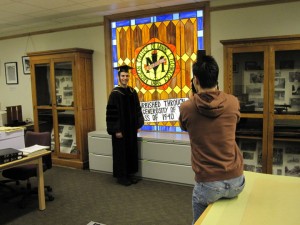
Photographer Calvin Goh (UMC) used the Archives Reading Room as a fitting backdrop for his images of recent graduate, Cameron Hartnell, PhD, Industrial Archaeology. Here, the photographer is captured at his craft:
Cameron’s doctoral research focused on the archaeological remains of the Arctic Coal Company on the island of Spitsbergen, or Svalbard. An earlier Tech grad, Scott Turner, spent six years in the early 20th century working for the ACC at Spitsbergen.
Through his doctoral research, Hartnell became quite familiar with the Scott Turner Collection, housed here at the Michigan Tech Archives. To honor the man whose papers were invaluable to his own research, Hartnell approached the Archives with a unique request: to wear Turner’s doctoral hood in the University’s midwinter commencement ceremonies.
Turner wore this hood when he received an honorary PhD from Michigan Tech in 1932 and it was donated to the Michigan Tech Archives along with corporate records, personal correspondence and other artifacts by Turner’s family following his death. According to Hartnell, the intricate folds and pockets of the graduation hood served a very practical purpose in the past. Students at one time kept a bit of bread or fruit in the pouches so they could continue their studies while they ate.

The following overview on Turner’s life and accomplishments is excerpted from an article by Erik Nordberg, first published in the Michigan Tech Alumnus, 2002.
Scott Turner began his mining career in a somewhat ordinary manner, completing his BS and Engineer of Mines degrees at the Michigan College of Mines in 1904 at the age of 24. A native of Lansing, he had completed an associate’s degree at Ann Arbor before taking up the mining trade as his life’s passion. Yet from these humble Michigan roots, numerous mining jobs and work as an assistant editor for the Mining & Scientific Press took him to the four corners of the globe within the first few years of his career.
In 1926, he received a call from the United States government requesting his service as Director of the Bureau of Mines. Although an important federal appointment, many noted its added significance under then-Secretary of Commerce Herbert Hoover, one of the nation’s most prominent mining engineers. Turner spent eight years at the helm of the BOM, overseeing difficult changes associated with the stock market crash of 1929 and the ensuing onset of the Great Depression. During this period, Turner returned to Houghton to receive an honorary Doctor of Engineering degree in 1932. He received similar honorary degrees from the University of Michigan, Colorado School of Mines, and Kenyon College.
A chance meeting with John Longyear in London in 1911 directed a major change in Turner’s career. The Marquette, Michigan, lumber and mining man was interested in potentially profitable iron and coal deposits in Spitsbergen, an unclaimed arctic island north of Scandinavia. Turner accepted the position of manager for Longyear’s European interests, an assignment that would keep his attention focused on Spitsbergen for nearly six years. In addition to a “small fixed annual salary,” he received a bonus of 5% of the company’s net profits.
His work in Spitsbergen was marked by many unusual feats. The mines proved particularly difficult to develop; only 750 miles below the North Pole, the Arctic Coal Company was the first company to successfully implement modern mining methods at so high a latitude. In addition, the land was “terra nullius,” meaning that no single nation had ownership of the place. Through permission of the U.S. government, Turner represented American interests in the region – perhaps the only time that a civilian engineer has been enlisted to maintain American sovereignty overseas.
It was on one of Turner’s many trips across to Spitsbergen that he became a participant in another of history’s infamous incidents. On May 7, 1915, as it neared the coast of Ireland, a German torpedo struck Turner’s ship, the S.S. Lusitania, just a few decks below the engineer’s cabin.
The mining engineer’s work continued in earnest. Following his discharge from the hospital, he continued his journey to Scandinavia and arranged for the sale of Longyear’s Spitsbergen properties to Norwegian interests (on his trip from England to Norway, his ship narrowly missed destruction by bombs dropped from raiding German Zeppelins). Looking to escape the growing European turmoil, Turner headed south, pursuing work in Peru, Chile and Bolivia. He completed a two-year stint in the Naval Reserves at the tail end of World War I and then spent the next seven years of his life as “Technical Head” for the Mining Corporation of Canada. This work took him to various parts of that country – as well as China, Mexico, Russia and South America — on exploratory and mine development work. He often traveled with his new wife, the former Amy Pudden, whom he had married in Lansing in 1919.
Following his departure from the Bureau, he pursued a variety of consulting work. At one point he was an officer or director of nine mining companies. He even returned to Spitsbergen to review the progress of mines he developed decades earlier. His life work was capped in 1957 when he received the Hoover Medal, a special honor commemorating civic and humanitarian achievements of engineers. Recipients are selected by a special board with representatives from the American Society of Mechanical Engineers (ASME), the American Society of Civil Engineers (ASCE), the American Institute of Chemical Engineers (AIChE), the Institute of Electrical and Electronics Engineers (IEEE) and the American Institute of Mining, Metallurgical and Petroleum Engineers (AIME).
Scott Turner died in July 1972, just one day shy of his 92 birthday. In his later years, when not hunting or fishing, Turner would talk regularly of his life’s adventures. But it was his spot on the Lusitania that always singled him out for the most attention. He responded to endless requests for interviews and completed dozens of questionnaires about the incident. In the mid-1950s Turner donated the Boddy life belt that had saved his life to the museum at Michigan State University. It is not clear what became of a cast iron medal he owned, minted in 1915 by the German government to celebrate the sinking of the Lusitania. The medal had been uncovered during some road construction in Washington, D.C. and had been presented to Turner as a survivor of this historic event.
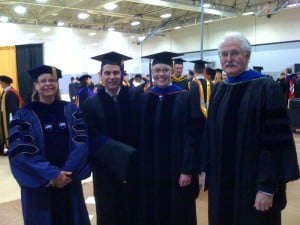
The staff of the Michigan Tech Archives congratulate Cameron Hartnell on his achievement and are pleased that our collections – both paper and fabric – were such integral parts of his study and graduation.
Genealogical holdings of the Michigan Tech Archives were highlighted in a feature article in the November 7, 2009 issue of Houghton’s Daily Mining Gazette. Here is the article:
Genealogy resources abound in Copper Country
By Garrett Neese, DMG Writer
HOUGHTON – Every year, thousands of people come to the Copper Country to research their heritage.
Fortunately for them, there are many resources available locally to help them with their quest.
Many of the records for which people are looking may be found in county courthouses. Houghton County’s clerk’s office has vital records dating back more than 150 years: births and deaths since 1867 (indexes starting 1893 and 1911, respectively), marriages since 1855 and naturalization records starting in 1848.
Some records are restricted, said Mary Sivonen, senior accounts processor with the county clerk’s office: Only family members may see birth records, while military discharge records may be seen by that person and a spouse.
Because of space and staffing constraints, Sivonen said people should call ahead and set aside a time to come.
“We limit it to just a couple at a time,” she said. “We don’t allow groups to come up because we only have a limited amount of space. The books are very large.”
Coming in to look at open records is free. There are small fees for services beyond that, including $2 for copies and $10 for any records that need to be typed.
The Michigan Technological University Archives and Copper Country Historical Collections has a wealth of sources, including Upper Peninsula census reports, local newspapers, tax and immigration records, and tract books showing purchases of land from the government.
Assistant archivist Julia Blair didn’t have total visitor numbers, but said hundreds of people come per month to do research.
There are microfilm archives from about 70 local papers, which can include pertinent information such as obituaries. Copies of the Daily Mining Gazette and its predecessor, the Portage Lake Mining Gazette, date back to 1862. There are other papers both major and minor, including three months of 1908 copies of the Hancock newspaper Wage Slave.
Other information includes census records, mine inspector reports of mining accidents, and Calumet & Hecla Mining Co. records, “probably the resource that is most valuable to people who come from outside the area,” Blair said.
The archives have telephone directories from Houghton and Keweenaw counties and Chassell, as well as their forerunner, the Polk directories, which included a list of residents with their job and address (for example, the 1898 Houghton County edition includes Dagenain Frederick, a laborer who lived at 129 Hecla St. in Laurium).
Many people also use Sanborn insurance maps, which shows the layout of streets in the town, as well as the businesses there at that point in time.
“It’s possible to trace a particular family dwelling and see if that home is still there,” she said.
Recently, Blair had a woman call who was interested in what business used to be in a particular building in South Range.
But as with any kind of historical research, Blair said, people should be prepared to put a little time into it.
“We can’t just type in a name, and say ‘Oh, we have this,'” she said.
In the event there’s nothing at the archives, they will also connect them to other resources, Blair said.
“It’s rare that we can’t connect somebody to some records in the past, but it has happened,” she said.
http://www.mininggazette.com/page/content.detail/id/507342.html?nav=5003
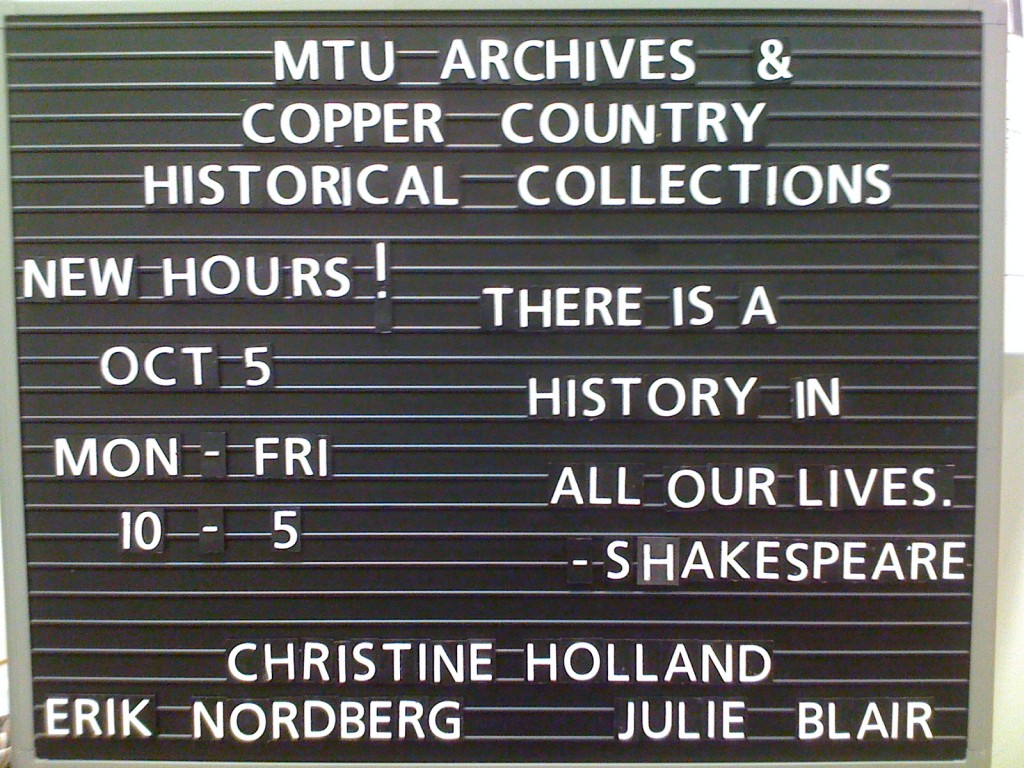
The Michigan Tech Archives is increasing its hours for public research. Effective Monday, October 5, 2009, the Archives will be open weekdays, Monday-Friday, 10:00am-5:00pm. This increases the total number of hours from 32 to 35 per week, makes the schedule more consistent from day to day, continues lunchtime hours for off-campus users, and will more effectively utilize existing staffing. Responding to input from user focus groups for additional hours, and benchmarking data of other institutions, these extended hours are in line with other archives with similar staffing levels.
Questions or comments may be shared to Erik Nordberg at the Michigan Tech Archives at 906-487-2505 or via e-mail at enordber@mtu.edu
Michigan Tech is working this summer to convert the former UPPCO building on the waterfront in downtown Houghton into its new “Lakeshore Center.”
A mention of the new project was included in an August 26 article by Stacey Ashcraft inThe Daily Mining Gazette:
As the university expands, there has been a demand for more space, so, last year, Michigan Tech purchased the old UPPCO building. The MTEC SmartZone received a $3.02 million federal Economic Development grant for renovations to the building. Gundlach Champion has been constructing the project. Now, the former UPPCO building, located on the Houghton Waterfront, has a new name – the Lakeshore Center. “The project is in process and we’re hoping to be fairly well complete for people to move in late this fall, about Nov. 1,” [MTU Facilities head John] Rovano said.
The Lakeshore Center will have three floors with three entities – the ground floor will house MTEC with a 20-year lease and the second floor will house Michigan Tech offices as well as Gundlach Champion, Rovano said. The third floor will house university administration, which is moving from Michigan Tech’s campus. “There are also going to be a number of departments that will be moving, such as accounting and administration,” he said. “There will be a whole lot of moving.”
What the story fails to mention, however, is the long history of this building on Houghton’s waterfront. Driving by the building this week, the renovations have begun to expose some clues to the building’s origins.
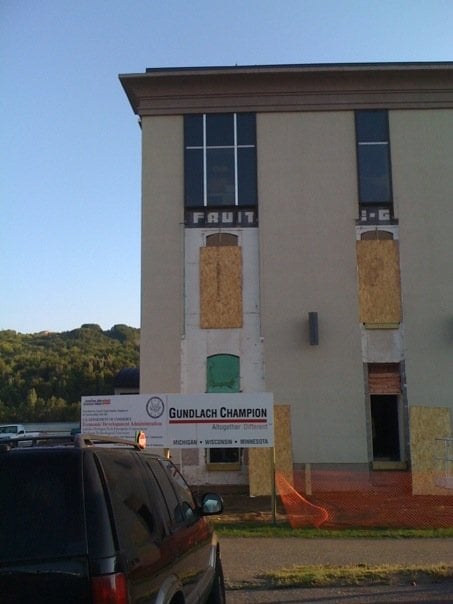
One can clearly read the word “fruit” — revealing the building’s former use as a waterfront warehouse.
Sources in the Michigan Tech Archives vertical files indicate the building was constructed in the early 1900s as a warehouse storage facility for the Peninsula Wholesale Grocery. A Sanborn fire insurance map for 1908 shows the original building covering only a single waterfront city lot; by 1917 it had enlarged to cover the 4 city lots it currently occupies.
Although the exact date is unclear, the building changed owners and was used for many decades as storage warehouse for the Cohodas-Paoli Company which specialized in the wholesale market for fruits and vegetables. In 1991, the building was renovated by the Upper Peninsula Power Company for use as its office headquarters. Michigan Tech finalized its purchase of the building from UPPCO in February 2008.
A visit to the Keweenaw Digital Archives (http://digarch.lib.mtu.edu/) finds many interesting historical photographs of the building.
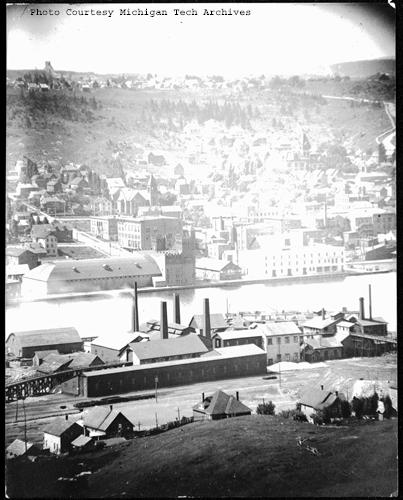
Although a bit overexposed, the above undated photograph looks from the Ripley hillside across Portage Lake toward downtown Houghton. The Cahodas-Paoli warehouse is a white building just right of center on the shoreline. (image# MTU Neg 01282 online at http://digarch.lib.mtu.edu/showbib.aspx?bib_id=643954)

This photograph appeared in the Tuesday, July 22, 1958, issue of The Daily Mining Gazette. The caption indicates that Cohodas-Paoli also owned the dock frontage near the building: “On Sunday the largest consignment of diesel or fuel oil ever to be loaded on a craft at the Cohodas-Paoli dock was paced aboard the Corps of Engineers sand sucker Hains. Slightly more than 20,000 gallons were pumped into the reservoir tank of the ship from three trucks and trailers with carrying tanks on each. The oil came from Gladstone in Detroit tank trucks. The sand barge has departed for dredging work near Bay City. It had been working for the past week at Lily Pond.” (image #MS051-016-001-006 online at http://digarch.lib.mtu.edu/showbib.aspx?bib_id=634850)
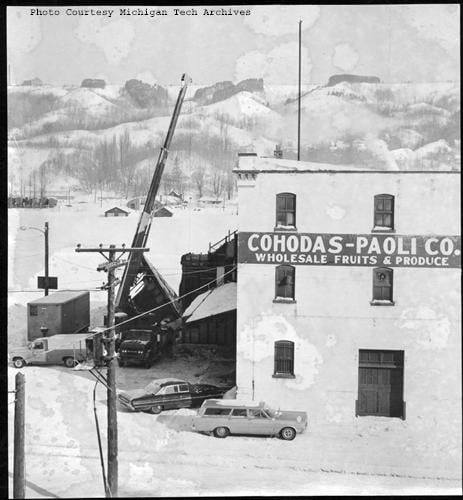
The photograph shown above appeared in the February 28, 1972, edition of The Daily Mining Gazette with the caption: “An enclosed three flight stairway, which was built in the 1940’s on the Cohodas-Paoli produce building in Houghton, is being dismantled by Mattila Contracting to make way for a new front on the building. The stairway was erected for the purpose of providing a separate entrance to the third floor of the building where at that time was located a dressmakers shop to employ women of the area during the World War II years. It was used as a branch of Ely Walker, clothing manufacturer, but was only in existence for a few years.” (image #MS051-037-001-004 online at http://digarch.lib.mtu.edu/showbib.aspx?bib_id=665407)
Some of the best photos, however, aren’t just about the warehouse building, but are those that catch it as a background element.
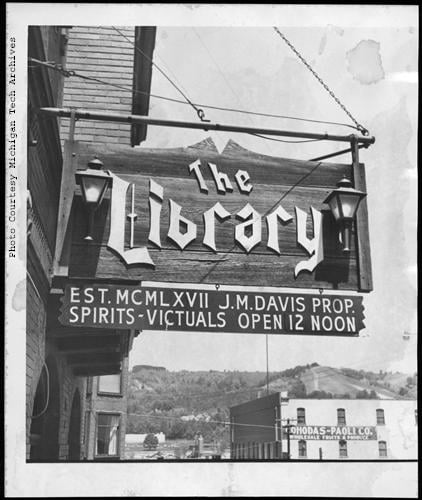
1972 and the Library Restaurant. (image #:MS051-038-001-002 online at http://digarch.lib.mtu.edu/showbib.aspx?bib_id=664611#)

Unknown date (maybe the 1950s?) with two Coast Guard sailors in front of the Gazette Building on Isle Royale Street. The Cohodas-Paoli warehouse is in the background. (image #MS044-005-077 online at http://digarch.lib.mtu.edu/showbib.aspx?bib_id=625735)
It’s great that Michigan Tech is giving this building new life as the Lakeshore Center — and also lots of fun to celebrate its 100+ year history in photographs as one of the many landmarks on Houghton’s waterfront.
Take some time to locate other photographs of this building in the Keweenaw Digital Archives at http://digarch.lib.mtu.edu/
One of the innovative features of the Keweenaw Digital Archives site allows visitors to add information they know about photographs in our collections. When you visit the site (http://digarch.lib.mtu.edu/) and conduct a search, the record for each image includes an area just below the photograph where you are invited to “Add Your Comments and Share Your Thoughts.”
This is an important role you can play in our work. Very few of the historical photographs and negatives we receive as donations come with any descriptive information. And it isn’t feasible for our staff to undertake research to create descriptions about each and every image in the collection (we already have more than 7,000 images in the digital archives site).
Your comments help subsequent researchers to find and evaluate photographs in the collection. And don’t worry whether you have a PhD in history — we’re looking for any information that can be helpful in understanding the content of an image. We do ask, however, that you include your name by either including it in the comment box or by creating and logging into an account that includes your name.
Here are a couple of recent examples in which visitors have left interesting and helpful comments.

The photograph above is image #MS003-009-013-13 from Our Calumet & Hecla Photograph Collection (you can view the record by clicking this link: http://digarch.lib.mtu.edu/showbib.aspx?bib_id=655295).
Notes on the original print indicated that it was the assembly room and study hall at Calumet High School, but George Mackey added the following details: “This photo is taken from the senior side of the assembly. The assembly room was organized with the freshman on the left side when facing the stage and then the sophmores, juniors and seniors as one moves to the right.”
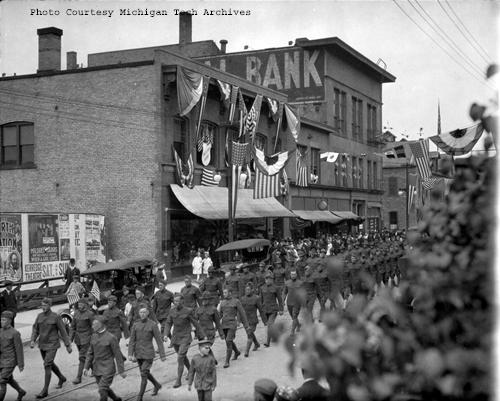
The photograph above is image #MS042-064-Z-616B from the Reeder Photographic Collection. (you can view the record by clicking this link: http://digarch.lib.mtu.edu/showbib.aspx?bib_id=597077).
Notes from Reeder’s personal photograph log indicated that this was a parade in the Houghton/Hancock area. A comment from Nicholas Faller added some valuable information: “Based on the movie poster , I believe this is the June 6,1919 parade in downtown Houghton . The Movie ” When Girl Loves ” was shown on June 6 & 7, 1919.”

The photograph above is image #MTU Neg 03461, taken by Russell M. Magnahi on October 9, 1985 (you can view the record by clicking this link: http://digarch.lib.mtu.edu/showbib.aspx?bib_id=627147).
Magnahi was interested in the history of Italians in the Upper Peninsula and took the photograph as the building was once a store owned by the Campioni family. A comment from Jan Campioni added more detail: “This was the original Campioni’s Market in West Hancock. It was established by Guido and Mabel Campioni in the late 1920’s. It was later run by Joseph and Margaret Campioni until their deaths. It was later run by their son Bill and then after his death by his sister Mary Anne Crooks. She sold it to the Keweenaw Co-op.”
We invite you to become “part of history” by browsing the thousands of images in the Keweenaw Digital Archives and sharing your thoughts, comments, memories, and other information.
Visit the Keweenaw Digital Archives at this address: http://digarch.lib.mtu.edu/
